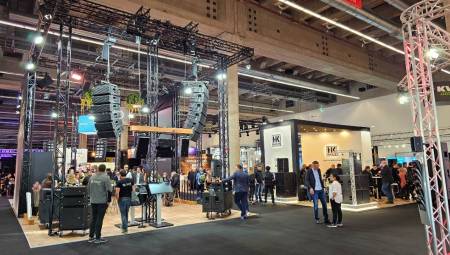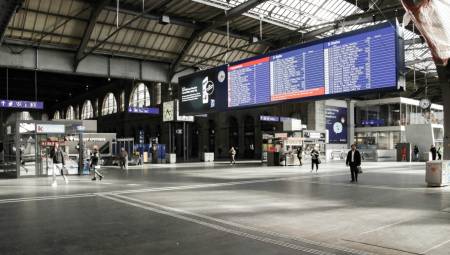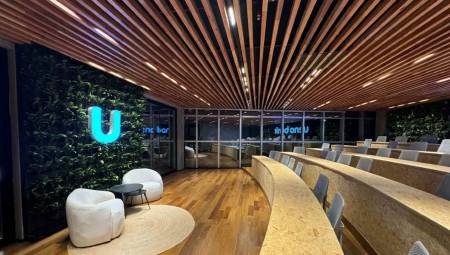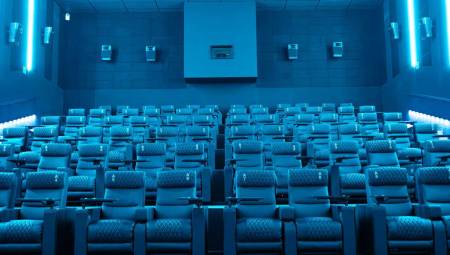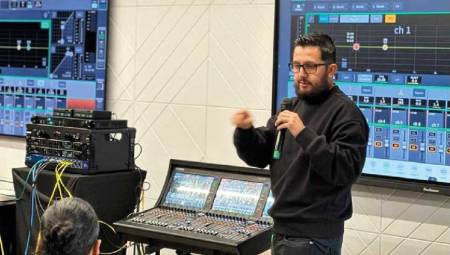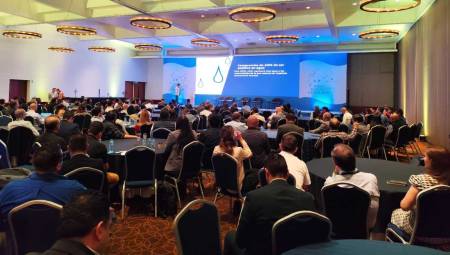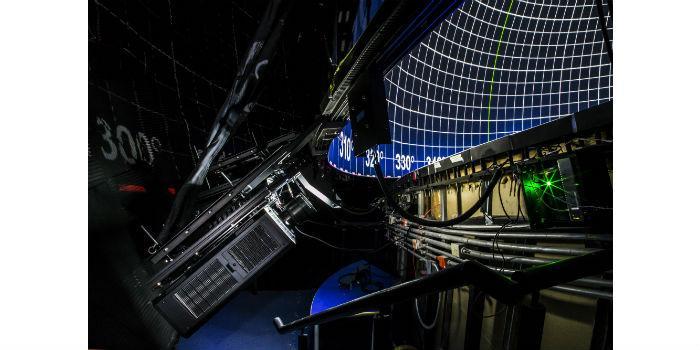 Mexico. The Domodigital Citibanamex is one of the biggest attractions of Papalote Museo del Niño, an enclosure dedicated to children's learning and entertainment through play, located in the Bosque de Chapultepec, in Mexico City. On the gigantic hemispherical screen of the Domodigital Citibanamex, films and programs are projected that transport children to the knowledge of our planet and the universe itself.
Mexico. The Domodigital Citibanamex is one of the biggest attractions of Papalote Museo del Niño, an enclosure dedicated to children's learning and entertainment through play, located in the Bosque de Chapultepec, in Mexico City. On the gigantic hemispherical screen of the Domodigital Citibanamex, films and programs are projected that transport children to the knowledge of our planet and the universe itself.
In autumn 2017, thirteen years after its inauguration, the Dome renewed for the second time the projectors in charge of giving life to the screen that provokes the admiration of children and adults. Once again, as in the first technological renovation, Panasonic was the brand chosen to incorporate the very new PT-RZ12K projectors and generate a simply spectacular image.
Laser projectors, the future of imaging
Papalote Museo del Niño remains at the forefront of vision by changing the eight projectors that make up the huge and enveloping screen of the Citibanamex Domodigital. The new Panasonic devices feature laser light source and 3-chip DLP technology, which reveals impressive video quality, greater luminosity, much lower power consumption and continuous operation, without the need for maintenance, for 20,000 hours, This translated to use in Papalote Museo del Niño means four years of uninterrupted operation, approximately 3 thousand functions per year.
Upon entering the Domodigital Citibanamex visitors find a hemispherical screen of 23 meters in diameter (with 13 meters high at the zenith) that offers a field of view of 360 degrees. To homogeneously cover the entire screen, the aforementioned eight Panasonic PT-RZ12K projectors with a resolution of 1920 x 1200 pixels and a video management system known as DigiStar 5, the digital reference platform for domes, planetariums and giant screens, are used. Six projectors cover the surrounding ring and two more are occupied for zenith coverage. The dome has a capacity for 269 people seated and six more in wheelchairs.
"This is the second time we have placed our trust in Panasonic projectors," says engineer Jorge Hernández, Manager of Mega Pantalla and Domodigital within Papalote Museo del Niño. "Already in 2011 we had done the first equipment renovation; at that time we changed suppliers and went from using nine projectors from a European firm to only eight, all from Panasonic. We selected them because their luminosity and the use of lenses, much more advanced and of greater angle, allowed us to reduce the number of equipment. But beyond that, we gain in reliability, image quality and service, key points for systems that work for a minimum time of ten hours every day of the year," he said.
The Panasonic projectors of the first renovation project, also of 3-chip DLP technology, used dual UHM (High Mercury Discharge) lamps with a luminosity of 10,000 lumens and a maximum service life of between 3 thousand hours. On the other hand, the new projectors installed in 2017 offer a luminosity of up to 12,000 lumens and an assured operation of 20 thousand hours, because by using a laser light source, with Solid Shine technology, there is no change of lamps and they do not suffer from the possible entry of dust, in addition to operating at a much lower temperature and not heating up, which translates into energy savings and use of air conditioning.
The purity and depth of the black color
"We have also gained in luminous density, the combination of projection and screen equals or exceeds the standard brightness of commercial cinemas," explains Jorge Hernández. "Another notable benefit with the switch to laser light source projectors was the increased contrast, it is something great that we can appreciate with the depth and purity of the "blacks". With the previous projectors, as much as we wanted, we always had a grayish tone, because there was always a trace of light that, however minimal (due to the use of the conventional light source), prevented the precise reproduction of the "blacks". This is something that has been appreciated by video makers and content creators who have marveled at the contrast range of these new Panasonic projectors."
The magic of content
Engineer Hernández explains the process of putting together a film for the Dome: "The visual contents have to come in a polar format. When we receive that sequence of images, specific "cuts" are assembled so that each projector has the image section that it must display. That information is sent to eight hard drive-based servers, then a master computer will be in charge of making the perfect synchrony between each of the eight video signals."
The experience at Domodigital Citibanamex is truly immersive. The audience receives the audiovisual impact and their reactions range from amazement to disbelief. The smile is a pleasant sign that the visit has been satisfactory.
The digital chain without degradation
All projectors are connected one by one by a ring of HD-SDI optical digital connections and through interfaces the video signal is sent, which remains stable, free of any degradation.
As for the benefits of daily operation, engineer Hernández points out the decrease in heat and ease in daily adjustment. "As a matter of principle, we will forget about the change of lamps, an expensive process that had to be very well programmed so as not to affect the schedule of functions. In addition, the operating temperature has decreased and that makes the equipment work better and its functional life is longer. On the other hand, our daily routine of reviewing and adjusting parameters has been simplified, as these projectors are more robust and resistant to possible mismatches due to the vibration generated by earthquakes or by the sound of the subwoofers used in the Dome. Even so, every day we calibrate the geometry and check the blending. We are perfectionists, as we are committed to providing the ultimate visual experience in each and every one of our functions."
Speaking of sound, the audiovisual experience of the Domodigital Citibanamex is completed with a 5.1-channel surround system, composed of thirty full-range speakers, in addition to eight subwoofers.
The mixture of contours and the search for perfect homogeneity
The Panasonic PT-RZ12K projectors have electronic Edge Blending adjustment, which allows the mixing of contours between adjacent screens and luminance control so that there are no differences in brightness and the desired homogeneity is achieved. In addition, the Color Matching function corrects for small variations in the color reproduction range of individual projectors. One of the advantages of Panasonic's software is that it allows you to perform color adjustment and uniformity correction on a single projector and apply those same parameters to the other projectors in the chain. Only minimal variations need to be made, eliminating the need to calibrate projectors one by one, saving valuable time for Papalote's technical staff.
"In a curved or spherical screen there will always be a tendency to the appearance of hotspots (points with greater luminosity), however, Panasonic's software has helped us to reduce them drastically and not only in terms of brightness, but in hue and color," explains Jorge Hernández. "One of the biggest advantages of these new projectors is the display of pastel colors. There is really great superiority in the intensity and smoothness of those colors with respect to the previous teams, the richness of the pastel tones is impressive, "says our interviewee.
Service and maintenance, Panasonic's priority
Panasonic was chosen not only for offering a technologically advanced solution, but for its vocation of pre and post sales service. "Since we started working with Panasonic de México, we had an unbeatable business relationship, we signed preventive and corrective maintenance contracts, which always resulted in the full availability of spare parts for the previous projectors. When it came time to switch to these laser light source projectors things were simple: there was no need to change the location of the devices and we were able to take advantage of the same lenses we had since seven years ago. The transition could not have been more transparent and effective," says the technical manager of the Dome.
The technicians and engineers of the Domodigital Citibanamex were in charge of the installation of the eight new PT-RZ12K projectors with the professional advice of a dumbbell of engineers from Panasonic de México and Panasonic Corporation, who carried out the first commissioning, executing the adjustments of Edge Blending and geometry, as well as the training of the staff on the functions of the new software.
Cutting-edge entertainment
Technically, the Domodigital Citibanamex and the Mega Screen of Papalote Museo del Niño operate with seven engineers responsible for the operation and maintenance of the audiovisual systems of both venues. "We are all highly trained to shape the implementation of the contents, but also for the daily operation, diagnosis and even maintenance of the systems," says Jorge Hernández, the team leader. "Our technicians are able to respond to any incident, they achieve a prompt response before the public notices any detail, of that we are proud," he concludes.
This is how Panasonic demonstrates its leadership in image for large venues. Its eight projectors with laser light source and 3-chip DLP technology have made the Citibanamex Domodigital, one of the best audiovisual attractions in Mexico City. The luminosity, color homogeneity, black color depth, flexibility in installation, long maintenance-free operating life and high quality service, make them the first and best option in critical installations.
Today, the Domodigital Citibanamex screens attractive educational films such as "The Ghost of the Universe" or "Maya Archaeo-Astronomy: Observers of the Universe". In addition, it operates for private functions and as an alternate venue for audiovisual festivals, such as the renowned MUTEK. This impressive prodigy of technological ingenuity is located inside Papalote Museo del Niño, in the 2nd section of the Chapultepec Forest, to the west of Mexico City.




